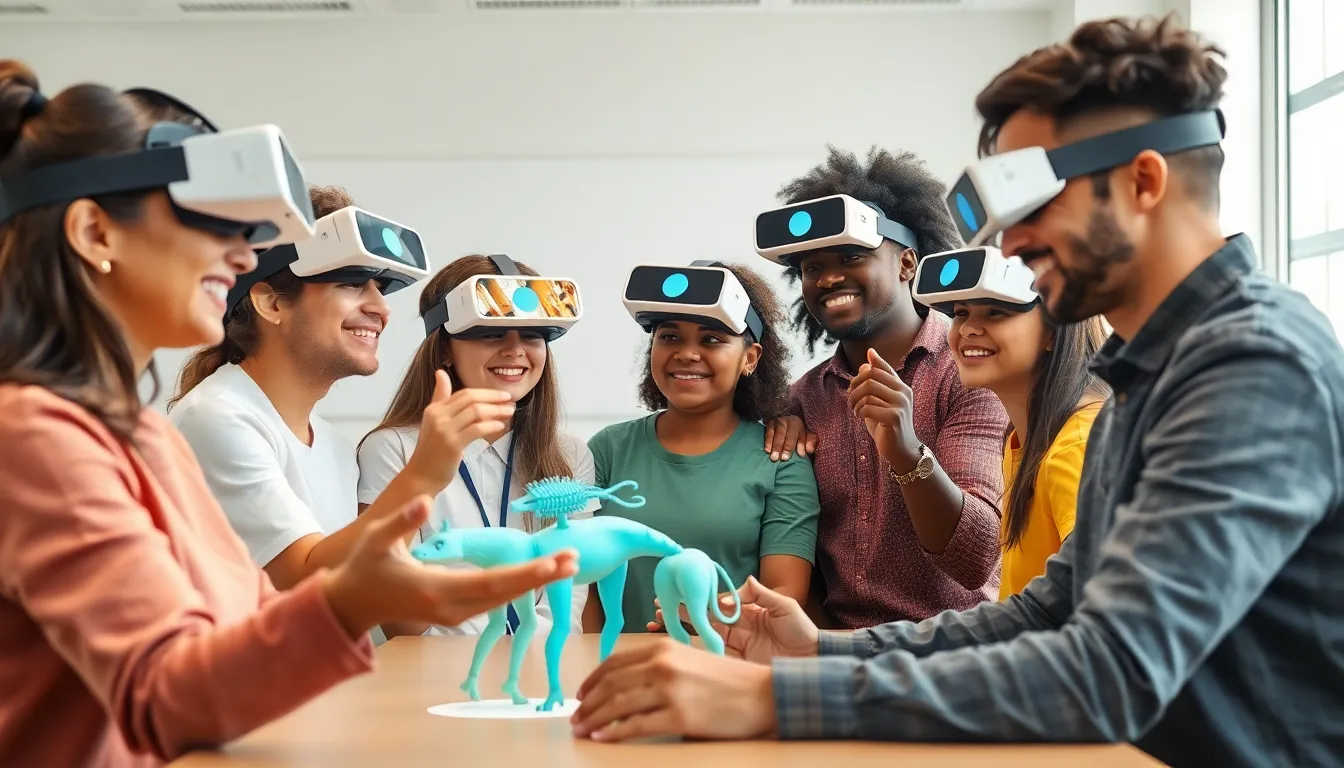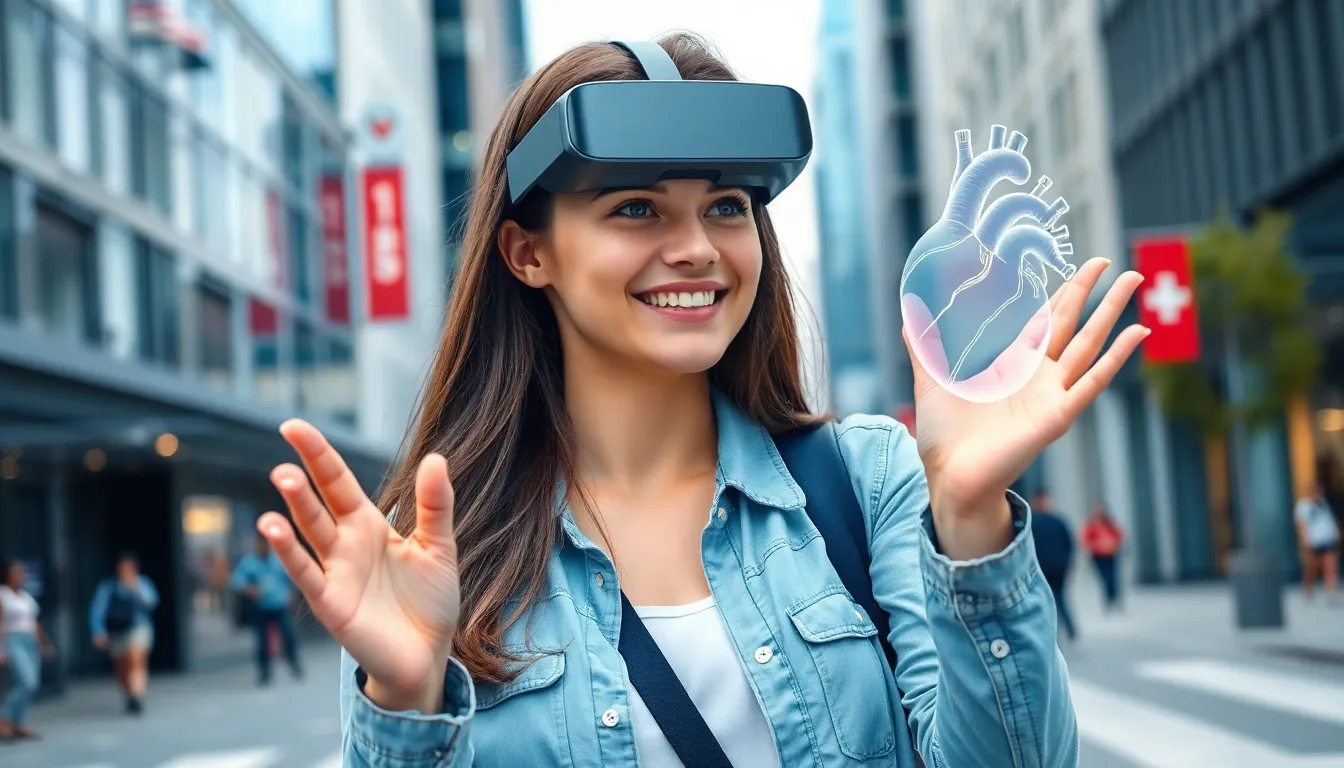Augmented reality training is revolutionizing how individuals and organizations approach learning and skill development. By blending digital content with the real world, this innovative technology creates immersive experiences that enhance engagement and retention. It’s no longer just about traditional classrooms; training can now occur in dynamic environments that mirror real-life scenarios.
As industries strive for efficiency and effectiveness, augmented reality offers a solution that caters to diverse learning styles. Whether it’s in healthcare, manufacturing, or education, AR training allows users to practice skills in a safe setting while receiving instant feedback. This transformative approach not only boosts confidence but also prepares individuals for the challenges they’ll face in their respective fields.
Table of Contents
ToggleOverview of Augmented Reality Training
Augmented reality (AR) training leverages digital information to enhance real-world environments, creating interactive educational experiences. AR technology overlays visual elements, sounds, and other sensory stimuli onto the user’s surroundings. This integration allows for practical, hands-on learning without the risks associated with traditional training environments.
Key Benefits
- Enhanced Engagement: AR training captures attention through immersive experiences. Users interact with 3D models and simulations, increasing motivation.
- Improved Retention: Memory retention improves when learners engage with content interactively. Studies show AR can increase knowledge retention rates by up to 70%.
- Customized Learning: AR accommodates various learning styles, allowing visual, auditory, and kinesthetic learners to benefit. Users receive instant feedback tailored to their performance.
- Realistic Simulations: AR creates lifelike scenarios, enabling users to practice skills relevant to their field. For instance, healthcare professionals can simulate surgeries without real-life consequences.
Industry Applications
- Healthcare: AR provides surgical training opportunities, letting users visualize anatomy and practice procedures in a controlled setting.
- Manufacturing: Workers can utilize AR for equipment training, gaining hands-on experience while familiarizing themselves with machinery.
- Education: AR transforms lesson plans by adding interactive elements, such as 3D models of historical artifacts or scientific concepts, enriching the learning experience.
Challenges and Considerations
- Cost: Initial investment in AR technology may be high. Organizations should assess long-term benefits versus upfront costs.
- Technical Skills: Training staff to effectively use AR tools requires ongoing support and training, especially in industries with rapid technological advancement.
- Content Development: Creating high-quality AR content demands specialized skills and resources, which can pose a barrier for some organizations.
Augmented reality training not only enhances learning experiences but also prepares individuals for future challenges across various fields. By embracing this innovative approach, organizations increase skill proficiency, ensuring a well-equipped workforce.
Benefits of Augmented Reality Training

Augmented reality training offers numerous advantages that significantly enhance the learning process. Two key benefits include improved engagement and increased retention of information.
Enhanced Engagement and Motivation
Enhanced engagement occurs through the immersive nature of augmented reality training. Users interact with lifelike simulations, fostering motivation and enthusiasm for the learning experience. Studies show that AR boosts user engagement levels by over 40% compared to traditional methods. Users actively participate in scenarios that replicate real-world tasks, making learning both practical and stimulating. Real-time feedback during these interactions keeps learners focused and eager to improve their skills.
Improved Retention of Information
Improved retention of information results from the interactive and visual elements of augmented reality training. Learners exposed to AR content retain up to 70% of the material, significantly higher than retention rates from conventional training methods. This increased retention stems from the combination of visual aids, hands-on practice, and immediate feedback. The multisensory approach engages various cognitive processes, making it easier for learners to recall information when needed.
Applications of Augmented Reality Training
Augmented reality (AR) training finds diverse applications across multiple sectors, enhancing learning experiences and skill acquisition effectively.
Healthcare and Medical Training
AR training significantly elevates healthcare and medical education by providing surgeons and medical students with lifelike simulations. Surgeons practice complex procedures on virtual patients, enhancing their skills without real-world risks. A study showed that AR-enhanced surgical training improves procedural knowledge retention by up to 80%. Medical professionals benefit from immediate feedback during simulations, which accelerates their skill mastery and boosts confidence. Furthermore, AR facilitates patient education, allowing patients to visualize their conditions, which enhances understanding and compliance with treatment plans.
Manufacturing and Maintenance
AR training in manufacturing and maintenance streamlines equipment handling and repair processes. Workers use AR to access real-time data overlaying machinery, guiding them through safe operation and troubleshooting. Training programs augmented with AR lead to a 30% reduction in errors, ensuring safer workplace environments. By visualizing assembly instructions and maintenance guidelines directly within their field of view, employees can complete tasks more efficiently. Real-time feedback during hands-on training sessions prepares workers for real-world challenges, significantly reducing the time needed for onboarding and enhancing skill retention.
Challenges in Augmented Reality Training
Several challenges exist in implementing augmented reality training, particularly in technical limitations and cost considerations.
Technical Limitations
Technical limitations affect the effectiveness of AR training programs. Hardware requirements can vary, necessitating advanced devices with powerful graphics capabilities. Users may encounter issues such as latency, which can disrupt the training experience. Additionally, compatibility problems may arise with existing software systems, requiring extensive updates or revisions. The development of high-quality AR content also demands specialized skills in 3D modeling and programming, often posing a barrier for organizations lacking in-house expertise.
Cost Considerations
Cost considerations present significant hurdles for organizations adopting AR training. Initial investments for AR technology can exceed thousands of dollars per device, including costs for software development and hardware maintenance. Ongoing expenses include regular updates and technical support, which can strain budgets. Small to medium-sized enterprises might find these barriers prohibitive, limiting AR adoption compared to larger corporations. Balancing upfront costs with potential long-term benefits often complicates decision-making processes regarding AR training implementation.
Future Trends in Augmented Reality Training
Emerging trends in augmented reality (AR) training highlight the technology’s potential to revolutionize learning methodologies. Adoption rates are increasing, and advancements in AR hardware and software signal a promising future.
- Integration with Artificial Intelligence
Integration of artificial intelligence (AI) with AR training enhances personalization. AI algorithms analyze individual learning patterns, tailoring experiences to meet unique needs. This synergy allows for adaptive learning environments that respond in real time.
- Widespread Adoption in Remote Learning
Widespread adoption of AR in remote learning settings improves accessibility. AR facilitates interactive simulations that bridge geographical gaps. Institutions increasingly utilize AR to deliver immersive training experiences, regardless of participant location.
- Enhanced Collaboration Features
Enhanced collaboration features in AR platforms enable teams to work together effectively. Real-time data sharing and interactive tools support group learning, allowing multiple users to engage with the same AR content simultaneously. This shift fosters a sense of community among remote learners.
- Focus on Skill-Based Training
A focus on skill-based training through AR applications addresses industry-specific demands. Fields such as manufacturing and healthcare increasingly utilize AR to simulate practical tasks. Users can practice critical skills in a controlled environment, preparing them for real-world scenarios.
- Increased Use of Wearable Technology
Increased use of wearable technology aims to expand the AR training landscape. Smart glasses and headsets offer hands-free interaction with digital content, allowing users to immerse themselves fully in the training experience. This trend enhances engagement and aids in skills transfer.
- Emphasis on Data Analytics
Emphasis on data analytics in AR training helps organizations assess training effectiveness. Learning outcomes are tracked through analytics tools, enabling continuous improvement of training programs. Organizations can refine content based on real-time feedback from participants.
- Cost Reductions Through Scalability
Cost reductions achieved through scalable AR solutions make the technology more accessible. Organizations can implement AR training on a larger scale without significant financial strain. Subscription models and cloud-based platforms allow for flexible budgeting.
- Improvement in Content Creation Tools
Improvement in content creation tools empowers organizations to develop bespoke AR experiences. User-friendly platforms enable subject matter experts to create training modules without extensive technical skills. This democratization of content creation accelerates AR adoption.
These trends mark a significant shift in AR training, enhancing its effectiveness while meeting the evolving needs of modern learners. As technology advances, AR training promises to play a critical role in shaping skill development across various industries.
Augmented reality training is revolutionizing how individuals acquire skills and knowledge across diverse industries. By providing immersive and interactive experiences, it not only enhances engagement but also significantly improves retention rates. As organizations embrace this innovative approach, they’re better equipped to prepare their workforce for real-world challenges.
While challenges such as technical limitations and costs exist, the benefits of AR training far outweigh these hurdles. With advancements in technology and the increasing accessibility of AR solutions, the future of training looks promising. Organizations that invest in AR training are likely to see a more skilled and confident workforce ready to tackle the complexities of their respective fields.






